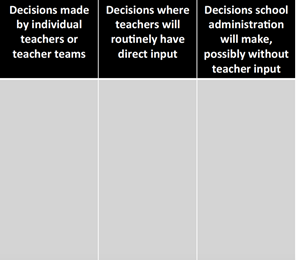Based on Leading a High Reliability School
A key aspect of leading a high reliability school is to put formal structures in place that clearly invite teachers to participate in specific aspects of decision-making for the school. In fact, when specific initiatives are driven by a staff decision-making process, they can quickly gain momentum and acceptance by the whole staff.
In their book Leaders of Learning, DuFour and Marzano (2011) state, “No single person has all the knowledge, skills, and talent to improve a school, or meet all the needs of every child in his or her classroom” (p. 2). The Wallace Foundation Study (2010) also addresses the concept of shared decision-making when they indicate that collective leadership has more of an influence on learning than any individual source and that when principals and teachers shared leadership, teachers reported stronger working relationships, and achievement was higher.
One aspect for leaders to consider is to decide on formal structures they want to put in place to practice shared decision-making. At Round Rock High School, I used a structure referred to as The Learning Leadership Team. This team included all administrators, all department heads, the school’s lead counselor, and an “open chair” available to teachers who were not formal members of the team but were interested in the work of the team or perhaps wanted to speak directly to an issue the team was going to take up.
Categorizing by Who Makes the Decision
The next aspect is for school leaders to clearly identify the specific types of decisions on which teacher input will be sought. In any school, there are three basic categories for decision-making:
- Decisions made by teachers and/or teacher teams
- Decisions where administration and teachers will decide together
- Decisions that will be made by administrators
Decision Categorization Template
The organizer that follows can be used to help guide leaders in their initial thinking based on the three types of decisions. Consider specific decisions that fall into each of the three columns and list them there to begin your process of identifying which specific decisions will involve teachers.








